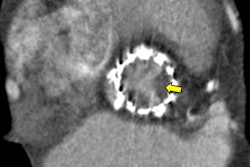
A deep-learning algorithm can improve identification of functionally significant coronary artery stenosis on coronary CT angiography (CCTA), potentially reducing the number of patients who need to receive invasive coronary angiography, according to Dutch research published online on 12 November in European Radiology.
Researchers from the University Medical Center Utrecht in the Netherlands trained a deep-learning algorithm to analyze the left ventricular myocardium (LVM) on resting CCTA in patients with intermediate-degree coronary stenosis. Adding deep-learning analysis to visual evaluation of coronary degree of stenosis yielded improved discrimination of functionally significant stenosis compared with just visual assessment alone.
"This could potentially decrease the number of patients undergoing invasive coronary angiography," wrote the researchers, led by Dr. Robbert W. van Hamersvelt.
Low specificity
While CCTA offers high sensitivity and negative predictive value for assessing the degree of coronary stenosis, the modality suffers from limited specificity for identifying the functional significance of a stenosis. As a result, invasive fractional flow reserve (FFR) remains the reference standard for indicating the functional significance of a coronary artery stenosis and guiding treatment, according to the researchers.
"However, due to its invasive nature and high cost, adoption of invasive FFR in clinical practice is limited, and the search for a noninvasive method that would determine functional significance of a stenosis continues," they wrote.
New techniques for noninvasive assessment of functional significance have been developed, including FFR derived from CT (FFRct). In addition, methods utilizing machine learning also have been proposed for classifying the left ventricular myocardium on resting CCTA for the presence of functionality significant stenosis. In their work, the Dutch researchers sought to apply a combined method of visual stenosis grading and deep learning-based analysis for intermediate-degree stenosis on CCTA.
"Deep-learning algorithms are able to learn complex patterns and relationships directly from the images without prior specification of which image features represent presence of disease, and thereby may be more sensitive to subtle changes in the LVM caused by functionally significant stenosis," the authors wrote.
Deep-learning analysis
To determine if deep learning could add value over visual scoring of coronary degree of stenosis, the researchers retrospectively selected patients who had underwent CCTA prior to an invasive FFR measurement. Patients with intermediate coronary degree of stenosis of 25% to 69% were then referred for fully automatic deep-learning analysis of the left ventricular myocardium. After the analysis, the algorithm extracted image features and then classified patients as having a nonsignificant or significant stenosis, according to the researchers.
Of the 126 patients ultimately included in the study, 81 (64%) had a functionally significant stenosis, which was defined as an FFR of 0.8 or less or the presence of angiographic high-grade stenosis (≥ 90% degree of stenosis).
| Diagnostic performance for identifying functionally significant coronary artery stenosis | ||
| Visual scoring of degree of coronary stenosis | Combination of visual scoring of coronary stenosis & deep-learning algorithm | |
| Sensitivity | 92.6% | 84.6% |
| Specificity | 31.1% | 48.4% |
| Area under the curve (AUC) | 0.68 | 0.76 |
"The combination of [degree of coronary stenosis] with [deep-learning] analysis of the LVM in intermediate-degree coronary stenosis may result in improved diagnostic performance for identification of patients with functionally significant coronary artery stenosis," the authors wrote.
While FFRct on resting CCTA has shown promising results (AUC = 0.79-0.93) for evaluating functionally significant stenosis, the technique relies on lumen segmentations that can be challenging or impossible in patients with high-density calcified plaque, motion or misalignment artifacts, and/or a prior coronary artery bypass graft or percutaneous coronary intervention, according to the researchers.
"Our proposed method may be less affected by these challenges as the analysis of intermediate stenosis is performed only on the LV myocardium," the authors wrote. "Results of the present study underscore the need to look beyond the coronary arteries in the quest to improve specificity of CCTA."
They also acknowledged that a combination of both techniques will likely to lead to further increases in specificity for identifying flow-limiting lesions in patients with intermediate-degree stenosis shown on CCTA.
"Future research is warranted to evaluate [the deep-learning] approach on patients with low pretest probability of obstructive coronary disease, more clinically encountered at CCTA," the authors wrote.



















